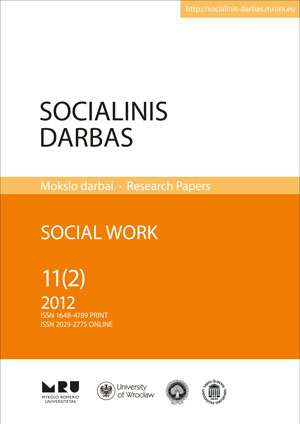Šeimos samprata: Lietuvos gyventojų subjektyvus požiūris
The Concept of Family: Subjective Approach of the Population of Lithuania
Author(s): Vida ČesnuitytėSubject(s): Social Sciences
Published by: Mykolas Romeris University
Keywords: family concept; modern family; postmodern family; nuclear family; extended family
Summary/Abstract: The aim of the paper is to present a family concept that is characteristic for the population of Lithuania. The research object is the opinion of Lithuanians as to what constitutes their family. The study hypothesis is as such: for the population of Lithuania a family is associated not only with the modern nuclear family, but also with extended family members and people beyond the nuclear and extended families; that means, that the family concept characteristic to the postmodern society is emerging in the minds of people in Lithuania. For the testing of the hypothesis the database of representative quantitative sociological study was used. This study is part of the ESF-funded project “Trajectories of family models and social networks: Intergenerational perspective” (http://famo-socnet.mruni.eu/ en/). For the collection of the empirical data, a questionnaire survey was applied. 2000 residents of Lithuania, representing people born in 1950-1955, 1960-1965, 1970-1975 and 1980-1985 were interviewed. Fieldwork was done between November, 2011 and May, 2012. For analysis of empirical data, descriptive statistical methods were applied. Research results confirm the research hypothesis: in the mind of the population of Lithuania, the concept of family has characteristics that are close to the postmodern family concept. The research findings that prove such a conclusion are as follow: 1) Although the majority of the population (70%) associate their family with the modern nuclear family, Lithuanians are not completely and totally focused on the nuclear family. Among the members of family they identify persons from their extended family and persons beyond the nuclear and extended families. 2) One tenth of population among their family members named first of all persons who cannot be prescribed to the nuclear family, extended family or non-family. They named primarily a partner (boyfriend or cohabitant), a former spouse or a former partner (boyfriend or cohabitant) as family members. This fact demonstrates the orientation of part of the population towards the non-traditional family model. 3) Among other features worth mentioning is the fact that in the concept of family, the kinship of maternal line is dominant. This partly reflects the changing roles and influence of men and women in the family, which is characteristic to the postmodern family. 4) The named family members are not limited to one or two generations and include persons from three or more generations, that is, according to the prominent sociologists, characteristic of the future family.
Journal: Socialinis darbas
- Issue Year: 11/2012
- Issue No: 2
- Page Range: 257-270
- Page Count: 14
- Language: Lithuanian

